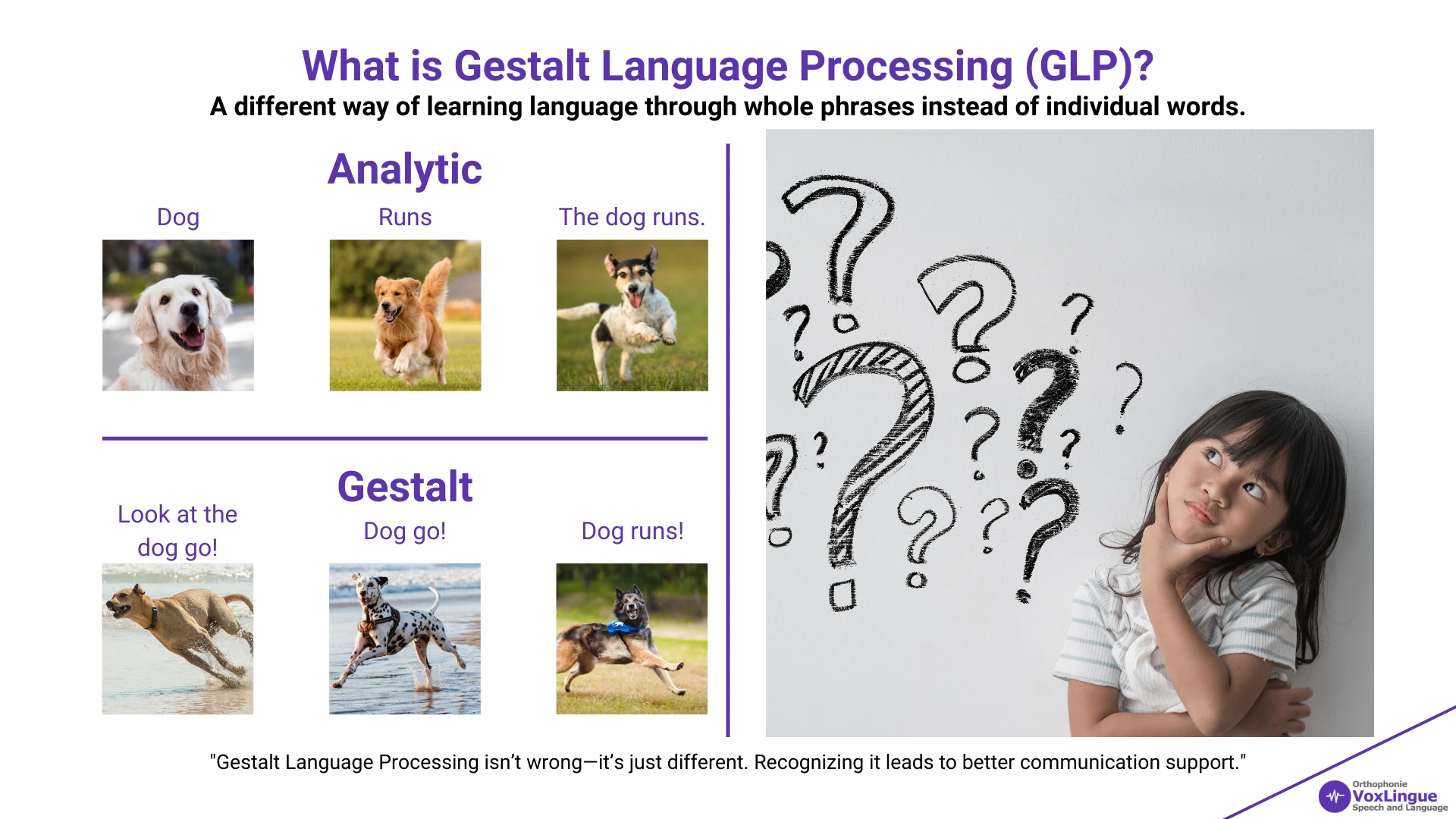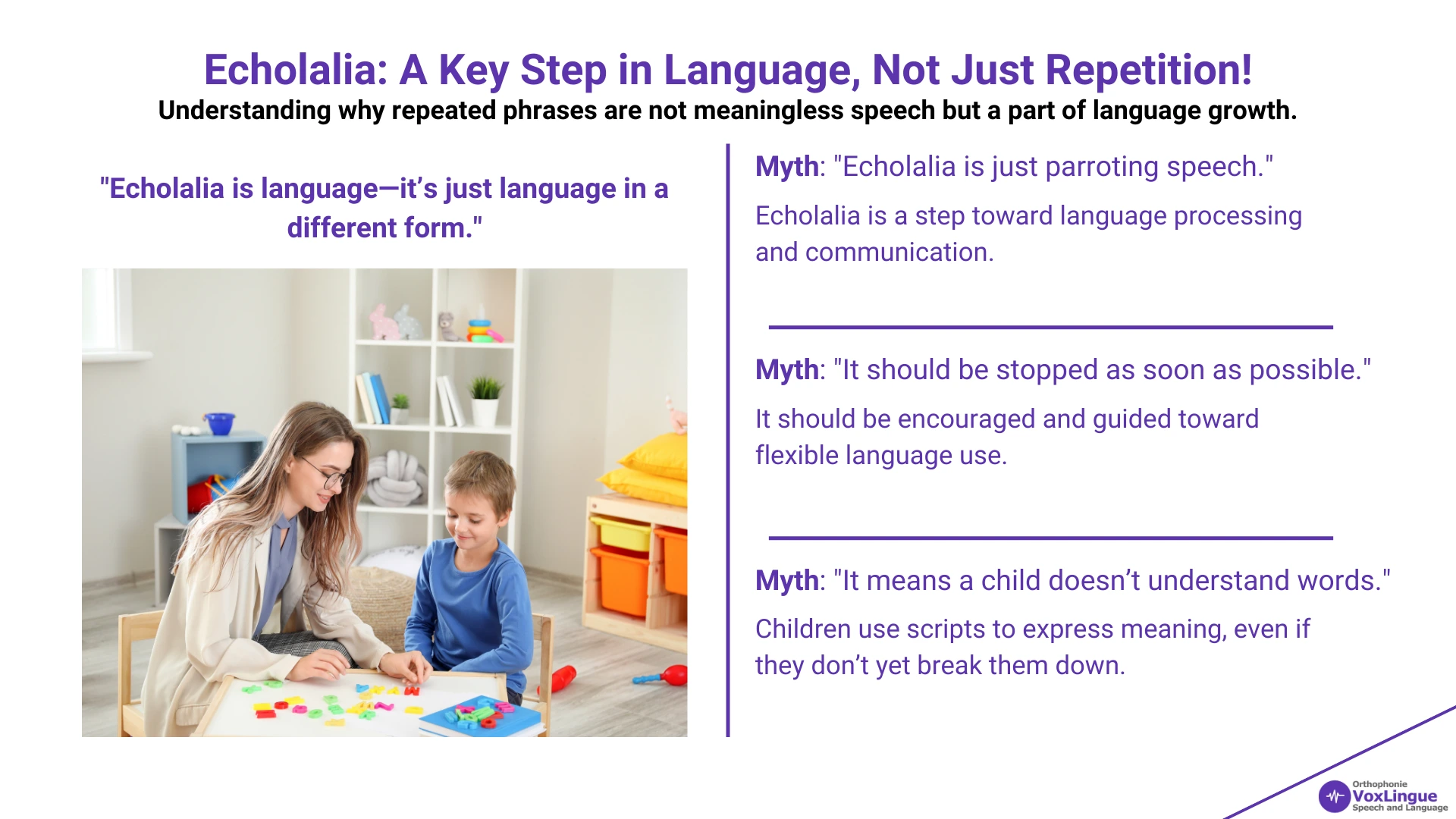Gestalt Language Processing: Understanding the Stages of Language Development and How to Support It



Read Part 2 on Gestalt Language Processing
Gestalt Language Processing (GLP) is a unique way of acquiring language that differs from the typical, word-by-word method. Instead of learning individual words and combining them into sentences, gestalt language processors acquire and use entire phrases or scripts before breaking them down into smaller, flexible components. This alternative path of language development is commonly observed in children with autism, speech delays, or apraxia, though it can also occur in neurotypical children. Understanding GLP is essential for parents, educators, and speech-language pathologists (SLPs) to provide appropriate support and avoid ineffective interventions.

GLP is a holistic approach to language learning, where individuals learn speech in large chunks rather than as individual words. A child who follows this developmental path may first use full phrases they have heard in specific contexts, such as:
These phrases, known as gestalts, carry meaning for the child as whole units, even if they do not yet understand the individual words within them. Over time, with the right support, the child begins to break down and remix these phrases, moving toward self-generated, flexible speech.
Recognizing GLP is crucial because traditional language intervention strategies often fail for gestalt processors. Many speech therapy approaches assume that children learn language analytically, meaning they acquire individual words first and then construct sentences. When applied to gestalt learners, these methods can be ineffective or even counterproductive.
By identifying and supporting GLP correctly:
GLP is most commonly associated with children on the autism spectrum, as many autistic individuals are natural gestalt processors. However, it is also observed in children with childhood apraxia of speech (CAS), speech delays, and sometimes in neurotypical children who initially acquire language through scripts. Identifying this language processing style early allows for better support, avoiding unnecessary frustration and misdiagnosis.
The majority of children learn language through an analytical process, acquiring single words and gradually building sentences:
Both approaches are valid ways to acquire language, but because most educational and therapy models are designed for analytical processors, gestalt learners often face challenges unless their unique learning path is recognized.
This article will explore every aspect of Gestalt Language Processing, including:
By the end of this guide, you will have a comprehensive understanding of Gestalt Language Processing and how to support individuals who follow this unique developmental path.

Gestalt Language Processing (GLP) is a developmental approach to language acquisition that differs from the traditional, analytic method most people use. Rather than learning individual words and gradually constructing sentences, gestalt processors acquire language in larger, pre-formed chunks. Over time, these chunks break down into smaller components, leading to more flexible, self-generated speech. Recognizing this processing style is crucial for parents, educators, and speech-language pathologists (SLPs) to provide effective support and interventions.
At its core, GLP is a holistic method of language acquisition where individuals learn language in “gestalts” or whole phrases rather than discrete words. These phrases are often memorized from external sources, such as:
Some key characteristics of gestalt language processors include:
Understanding these characteristics helps caregivers and professionals interpret echolalia as meaningful communication rather than random repetition.
Most children follow an analytic language processing pathway, learning words individually and gradually combining them into sentences. For example:
Gestalt processors, on the other hand, learn in large chunks first, such as:
This fundamental difference means gestalt language learners require different strategies for language development—ones that acknowledge their need to process and reshape full phrases rather than focusing on individual word acquisition from the start.
Gestalt Language Processing follows a predictable developmental sequence, moving from rigid, memorized scripts to flexible, self-generated speech. This progression is often described in four key stages:
Progress through these stages varies by individual, and some may move between stages fluidly rather than in a strictly linear way. However, this continuum helps speech-language pathologists and caregivers identify where a child is in their language development and provide appropriate support.

Children who process language gestaldtically often use phrases that reflect their experiences, emotions, or learned interactions. These phrases might be taken from real-life conversations, media, or routines.Examples of Stage 1 Gestalt Phrases include:
As children progress to Stage 2 (Mitigated Gestalts), their phrases start changing:
By Stage 3 and beyond, their speech becomes more flexible and self-generated:
Recognizing these evolving patterns helps professionals and caregivers support language growth without forcing unnatural corrections. Instead of pushing children to say things the “right” way immediately, it’s more effective to expand on their existing scripts and guide them through the natural progression toward self-generated speech. Gestalt Language Processing is a fascinating and valid way of learning language that, when understood, can lead to better support, communication, and quality of life for those who process language this way.
Gestalt Language Processing follows a predictable developmental sequence, where individuals progress from using memorized phrases to forming flexible, self-generated speech. This process occurs in four key stages, though progress is not always linear—some children may move back and forth between stages before fully transitioning into analytic language processing. Understanding these stages allows parents, educators, and speech-language pathologists (SLPs) to provide the right support at the right time.
At this stage, children repeat entire phrases verbatim from their environment, whether from caregivers, media, or past experiences. These phrases, known as gestalts, function as whole units of meaning rather than separate words.
Characteristics of Stage 1
Examples of Stage 1 Gestalts
At this stage, the goal is not to eliminate echolalia but to recognize it as meaningful communication and help the child move toward more flexible language use.
In this stage, children begin modifying their gestalts by mixing and matching parts of different phrases. This is the first step toward more flexible speech and a sign that they are internalizing language patterns.
Characteristics of Stage 2
Examples of Stage 2 Speech
At this stage, caregivers and SLPs can model and expand language naturally, helping children refine their speech while still respecting their natural progression.

At this stage, the child begins breaking apart phrases into individual words and using them more freely in novel ways. This marks a significant step toward self-generated, analytic language processing.
Characteristics of Stage 3
Examples of Stage 3 Speech
At this stage, language intervention focuses on reinforcing self-generated speech by encouraging spontaneous expression and offering new vocabulary in meaningful contexts.
At this final stage, the child has transitioned to full analytic language processing, meaning they no longer rely on gestalts but instead construct language from individual words.
Characteristics of Stage 4
Examples of Stage 4 Speech
At this point, the child’s language development is aligned with typical language acquisition, though they may retain some residual gestalt patterns in specific phrases or expressions.
Stage 1 Challenges
Stage 2 Challenges
Stage 3 Challenges
Stage 4 Challenges
Observational Clues
Assessing Progression
Understanding these stages ensures that caregivers and therapists support children at their current level rather than pushing them toward analytic processing too soon. Recognizing and respecting each stage of Gestalt Language Development allows children to move at their own pace toward natural, self-generated speech while feeling validated and understood.

Gestalt Language Processing is a valid and natural way of acquiring language that differs from the traditional analytic approach. Instead of learning words individually and building sentences from the ground up, gestalt processors acquire and use whole phrases before breaking them into smaller, flexible components over time. Recognizing the four developmental stages—from echolalia and scripts to fully self-generated speech—allows parents, educators, and speech-language pathologists to provide the right support at the right time.
Each stage presents unique challenges but also opportunities for meaningful engagement. Stage 1 echolalia is not meaningless repetition—it’s communication. As children move into Stage 2 and begin modifying their scripts, they require modeling and support rather than correction. By Stage 3, they start generating their own phrases, leading to Stage 4, where language is flexible and fully self-generated.
Understanding these stages is the first step in supporting a gestalt language processor’s journey toward effective communication. However, identifying the stages is only part of the equation—the next crucial step is learning how to support and guide gestalt learners effectively.
In the next article, we will explore:
By deepening our understanding of who gestalt processors are and how they communicate, we can begin tailoring interventions and communication strategies to their unique learning style. Stay tuned for the next article as we continue breaking down Gestalt Language Processing and how to best support it.